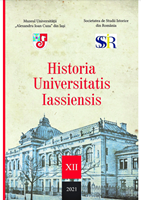Institutul Academic din Iași: structura și formarea personalului educativ
The Academic Institute of Iași: Composition and Training of the Staf
Author(s): Gheorghe BaciuSubject(s): History, Local History / Microhistory, Military history, School education, Higher Education , Sociology of Education
Published by: Editura Universităţii »Alexandru Ioan Cuza« din Iaşi
Keywords: Institutul Academic; private education; teachers; students; Mavrocordat Palace; Iași;
Summary/Abstract: On July 27, 1866, six young state school teachers from Iași (Ioan Alexandru Ciutea, Neculai Culianu, D. Chinezu, Ioan M. Melik, Pavel Paicu, Petru Poni), all graduates of universities abroad, established an association whose purpose was opening a fee-charging boarding school called The Academic Institute [„Institutul Academic”]. This private highschool’s main goal was to train students ‘from the earliest age’ for the baccalaureate exam, which was a requirement for access to higher education. As a result, The Academic Institute had to include all stages of undergraduate education (primary, lower secondary and upper secondary), a baccalaureate training section (class) for graduates of other private secondary schools and another training section for the Military School. The very thorough way in which this unit was organized and run was outlined both in the ‘Association Act’ and in the Institute’s Regulations, which were probably drafted based on the model of the schools that its six founders had attended in various Western countries. In the autumn of the same year (1866), the Academic Institute began its activity in two buildings, each two stories high, in the yard of what is today the Infectious Diseases Hospital of Iași. In 1870, it moved into a building purchased a year previously, which had belonged to the Phanariot prince Constantin Mavrocordat and had been used as a prince’s residence, which was why it was also known as the Princely Court of Sărărie. The Academic Institute made itself known from the start as an elite school, first and foremost because of the prestige of its instructors, many of whom were university professors: founders N. Culianu, I. Ciure, I. M. Melik, Petru Poni and Titu Maiorescu (replacing D. Chinezu, who had died in 1867), Alexandru D. Xenopol, Dimitrie Brândză, Ioan Caragiani, Grigore Cobălcescu, Constantin (Coco) Dumitrescu-Iași, Constantin Leonardescu, Gavril Muzicescu, Ștefan Vârgolici, Andrei Vizanti, Nicolae Quintescu. They were joined by a few teachers who, despite not being part of the academic milieu, were highly appreciated for the thoroughness of their training, the talent they showed in certain areas of knowledge or creation, for their cultural baggage: Samson Bodnărescu, Vasile Burlă, Grigore Buțureanu, Gr. L. Cernescu, Mihai Eminescu, Alexandru Lambrior, Anton Naum etc. The Academic Institute’s elitist nature was also determined by the fact that its students, originating from all Moldavian counties, several counties from Southern Romania and even Macedonia, were members of society’s wealthy families, a selection determined by the financial and material obligations imposed upon those who chose this school. Even if there were students from such families who were not passionate about studying, most of the Academic Institute’s students treated their baccalaureate training quite seriously. Proof of this are its 152 baccalaureate holders (of 209 graduates from the baccalaureate training section) who continued their training in universities at home or abroad, becoming scientists, publicists, writers, legal experts, teachers, politicians such as Al. D. Xenopol (the Institute’s first baccalaureate holder), Gavril (Gabriel) Socor, Leon C. Cosmovici, Constantin Meissner, Nicolae Volenti, Petru Misir, V.G. Morțun, Constantin Mille, Xenofon Gheorghiu etc. The Academic Institute ended its activity in 1879 as a result of its merger with the New Highschool, under the name The United Institutes [„Institutele Unite”].
Journal: Historia Universitatis Iassiensis
- Issue Year: 2021
- Issue No: 12
- Page Range: 59-81
- Page Count: 23
- Language: Romanian

